
Thyme is a culinary herb consisting of the dried aerial parts of some members of the genus Thymus of flowering plants in the mint family Lamiaceae. Thymes are native to Eurasia and north Africa. Thymes have culinary, medicinal, and ornamental uses. The species most commonly cultivated and used for culinary purposes is Thymus vulgaris, native to Southeast Europe.

In botany, a drupe is a type of fruit in which an outer fleshy part surrounds a single shell of hardened endocarp with a seed (kernel) inside. Drupes do not split open to release the seed, i.e., they are indehiscent. These fruits usually develop from a single carpel, and mostly from flowers with superior ovaries.

Hypericum perforatum, commonly known as St John's wort, is a flowering plant in the family Hypericaceae. It is a perennial plant that grows up to 1 metre tall, with many yellow flowers that have clearly visible black glands around their edges, long stamens, and three pistils. Probably a hybrid between the closely related H. attenuatum and H. maculatum that originated in Siberia, the species is now found worldwide. It is native to temperate regions across Eurasia and North Africa, and has been introduced to East Asia, Australia, New Zealand, and parts of North and South America. In many areas where it is not native, H. perforatum is considered a noxious weed. It densely covers open areas to the exclusion of native plants, and is poor grazing material. As such, methods for biocontrol have been introduced in an attempt to slow or reverse the spread of the species.

Hypericum is a genus of flowering plants in the family Hypericaceae. The genus has a nearly worldwide distribution, missing only from tropical lowlands, deserts and polar regions. Many Hypericum species are regarded as invasive species and noxious weeds. All members of the genus may be referred to as St. John's wort, and some are known as goatweed. The white or pink flowered marsh St. John's worts of North America and eastern Asia are generally accepted as belonging to the separate genus TriadenumRaf.

Daphne is a genus of between 70 and 95 species of deciduous and evergreen shrubs in the family Thymelaeaceae, native to Asia, Europe and north Africa. They are noted for their scented flowers and often brightly coloured berries. Two species are used to make paper. Many species are grown in gardens as ornamental plants; the smaller species are often used in rock gardens. All parts of daphnes are poisonous, especially the berries.

The genus Thymus contains about 350 species of aromatic perennial herbaceous plants and subshrubs in the family Lamiaceae. It is native to the Old World.
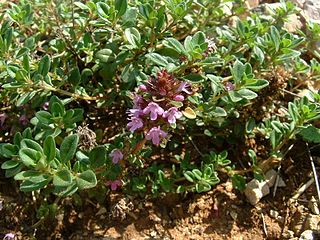
Thymus serpyllum, known by the common names of Breckland thyme, Breckland wild thyme, wild thyme, creeping thyme, or elfin thyme, is a species of flowering plant in the mint family Lamiaceae, native to most of Europe and North Africa. It is a low, usually prostrate subshrub growing to 2 cm (1 in) tall with creeping stems up to 10 cm (4 in) long. The oval evergreen leaves are 3–8 mm long. The strongly scented flowers are either lilac, pink-purple, magenta, or a rare white, all 4–6 mm long and produced in clusters. The hardy plant tolerates some pedestrian traffic and produces odors ranging from heavily herbal to lightly lemon, depending on the variety.
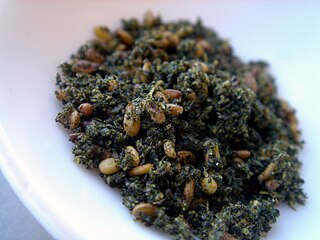
Za'atar is a Levantine culinary herb or family of herbs. It is also the name of a spice mixture that includes the herb along with toasted sesame seeds, dried sumac, often salt, and other spices. As a family of related Levantine herbs, it contains plants from the genera Origanum (oregano), Calamintha, Thymus, and Satureja (savory) plants. The name za'atar alone most properly applies to Origanum syriacum, considered in biblical scholarship to be the ezov of the Hebrew Bible, often translated as hyssop but distinct from modern Hyssopus officinalis.
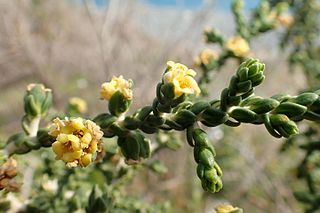
The Thymelaeaceae are a cosmopolitan family of flowering plants composed of 50 genera and 898 species. It was established in 1789 by Antoine Laurent de Jussieu. The Thymelaeaceae are mostly trees and shrubs, with a few vines and herbaceous plants.
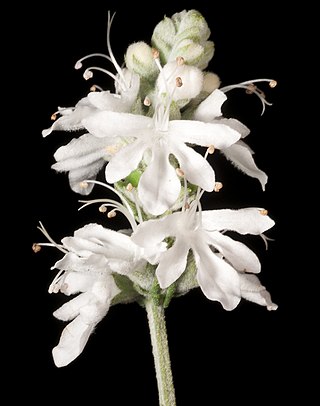
Teucrium is a cosmopolitan genus of flowering plants in the mint family Lamiaceae, commonly known as germanders. Plants in this genus are perennial herbs or shrubs, with branches that are more or less square in cross-section, leaves arranged in opposite pairs, and flowers arranged in thyrses, the corolla with mostly white to cream-coloured, lobed petals.
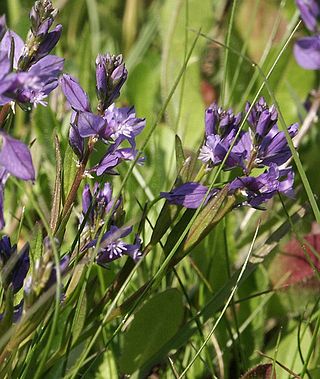
Polygala is a large genus of flowering plants belonging to the family Polygalaceae. They are commonly known as milkworts or snakeroots. The genus is distributed widely throughout much of the world in temperate zones and the tropics. The genus name Polygala comes from the ancient Greek "much milk", as the plant was thought to increase milk yields in cattle.
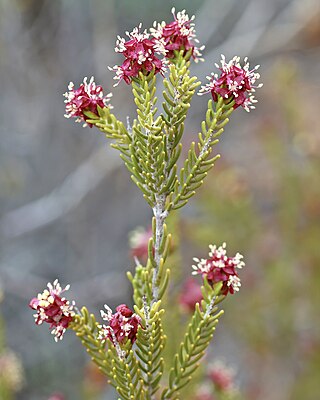
Passerina is a genus in the plant family Thymelaeaceae, native to southern Africa. They are ericoid bushes growing largely in fynbos and other Southern African scrub habitats.
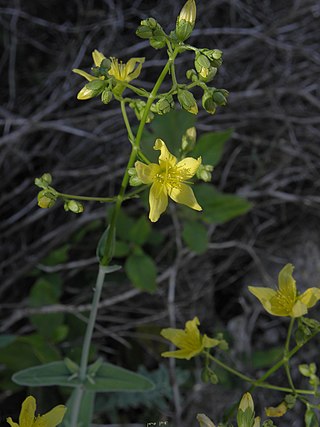
Hypericum lanuginosum, or downy St. John's wort, is a perennial herb, a flowering plant in the St. John's wort family Hypericaceae.

Diarthron is a genus of flowering plant in the family Thymelaeaceae. The precise limits of the genus are uncertain. When broadly circumscribed to include Dendrostellera and Stelleropsis, it consists of annual and perennial herbaceous plants and small shrubs, with reddish, white or green flowers lacking petals. It includes 16 species which range from southern European Russia and the Caucasus through Western and Central Asia through China and Mongolia to Korea and the Russian Far East.

Hypericum przewalskii, commonly called Przewalski's St. John's wort, is a flowering plant in Hypericumsect. Roscyna that is native to China.

Thymelaea hirsuta, boalaga (Spanish), bufalaga, mitnan (Arabic) or shaggy sparrow-wort, is a xerophytic shrub which can grow to 2 metres in height and has a root system reaching depths of up to 3.5m. Some noteworthy characteristics of this species are the tiny size of its leaves and flowers and that both are also fleshy. Like many other species belonging to the family Thymelaeaceae, it is a toxic plant with medicinal properties that also yields a strong fibre used in the making of rope and paper.
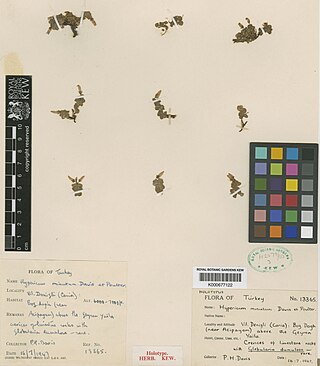
Hypericum minutum is a species of flowering plant in the St John's wort family Hypericaceae. It is a small perennial herb that grows in tufts. It has slender and brittle stems, flowers in clusters of one to three, yellow petals with black and amber glands, few stamens, and a seed capsule with narrow grooves. H. minutum is closely related to H. huber-morathii and H. sechmenii and resembles a smaller form of the latter plant. The plant is endemic to Turkey, and is found among limestone rocks in a limited region of southwestern Anatolia. Originally excluded from a comprehensive monograph of Hypericum, the species' placement within the genus is unclear. It has been placed in both section Adenosepalum and section Origanifolium.

Thymelaea passerina, the spurge flax, sparrow weed, mezereon, or annual thymelaea, is a species of flowering plant in the family Thymelaeaceae. It is native to central and southern Europe, the Middle East, Central Asia, the western Himalayas, and Xinjiang in China, and it has been introduced to central North America, and to South Australia. An erect annual from 6 to 61 cm tall, it is typically found in steppes, disturbed areas, and old fields.
















